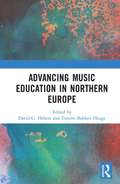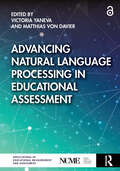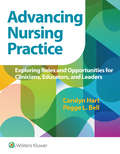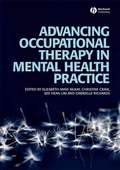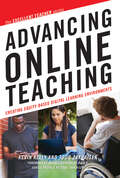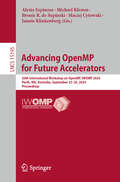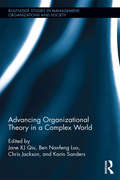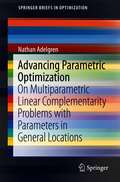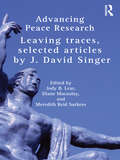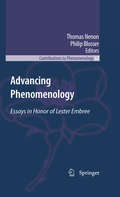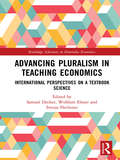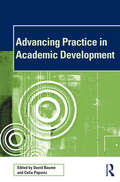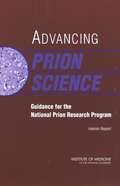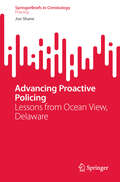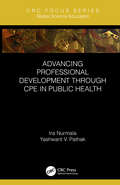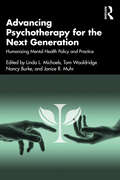- Table View
- List View
Advancing Music Education in Northern Europe
by David G. Hebert Torunn Bakken HaugeAdvancing Music Education in Northern Europe tells the story of a unique organization that has contributed in profound ways to the professional development of music teachers in the Nordic and Baltic nations. At the same time, the book offers reflections on how music education and approaches to the training of music teachers have changed across recent decades, a period of significant innovations. In a time where international partnerships appear to be threatened by a recent resurgence in protectionism and nationalism, this book also more generally demonstrates the value of formalized international cooperation in the sphere of higher education. The setting for the discussion, Northern Europe, is a region arguably of great importance to music education for a number of reasons, seen, for instance, in Norway’s ranking as the “happiest nation on earth”, the well-known success of Finland’s schools in international-comparative measures of student achievement, how Sweden has grappled with its recent experience as “Europe’s top recipient of asylum seekers per capita”, and Estonia’s national identity as a country born from a “Singing Revolution”, to name but a few examples. The contributors chronicle how the Nordic Network for Music Education (NNME) was founded and developed, document its impact, and demonstrate how the eight nations involved in this network – Norway, Iceland, Denmark, Sweden, Finland, Estonia, Latvia, and Lithuania – are making unique contributions of global significance to the field of music education.
Advancing Natural Language Processing in Educational Assessment
by Matthias Von Davier Victoria YanevaAdvancing Natural Language Processing in Educational Assessment examines the use of natural language technology in educational testing, measurement, and assessment. Recent developments in natural language processing (NLP) have enabled large-scale educational applications, though scholars and professionals may lack a shared understanding of the strengths and limitations of NLP in assessment as well as the challenges that testing organizations face in implementation. This first-of-its-kind book provides evidence-based practices for the use of NLP-based approaches to automated text and speech scoring, language proficiency assessment, technology-assisted item generation, gamification, learner feedback, and beyond. Spanning historical context, validity and fairness issues, emerging technologies, and implications for feedback and personalization, these chapters represent the most robust treatment yet about NLP for education measurement researchers, psychometricians, testing professionals, and policymakers.
Advancing Nuclear Medicine Through Innovation
by National Research Council Institute of Medicine of the National AcademiesNearly 20 million nuclear medicine procedures are carried out each year in the United States alone to diagnose and treat cancers cardiovascular disease and certain neurological disorders. Many of the advancements in nuclear medicine have been the result of research investments made during the past 50 years where these procedures are now a routine part of clinical care. Although nuclear medicine plays an important role in biomedical research and disease management its promise is only beginning to be realized. Advancing Nuclear Medicine Through Innovation highlights the exciting emerging opportunities in nuclear medicine which include assessing the efficacy of new drugs in development individualizing treatment to the patient and understanding the biology of human diseases. Health care and pharmaceutical professionals will be most interested in this book's examination of the challenges the field faces and its recommendations for ways to reduce these impediments.
Advancing Nursing Practice: Exploring Roles and Opportunities for Clinicians, Educators, and Leaders
by Carolyn Hart Pegge BellAdvancing Nursing Practice: Exploring Roles and Opportunities for Clinicians, Educators, and Leaders helps your students understand how to apply classroom knowledge to eventual professional practice as a CRNA, CNM, CNS, or NP/DNP, or in a faculty or administrative position. With the book’s succinct, conversational style, you can easily focus their attention on the core competencies, practices, leadership styles, and other essential topics. This brand-new volume features interviews with advanced practice nurses in active practice in the book as well as videos available online.
Advancing Nutrition and Food Science: 80th Anniversary Of The Food And Nutrition Board: Proceedings Of A Symposium
by Food and Nutrition Board National Academies of Sciences, Engineering, and Medicine Health and Medicine DivisionThe Food and Nutrition Board (FNB) of the National Academies of Sciences, Engineering, and Medicine was convened in 1940 in response to a request from the U.S. National Defense Advisory Commission to the National Academy of Sciences for aid in studying problems of nutrition in the United States. Today the FNB is the focal point for activities concerned with food, nutrition, and food safety, and their roles in health maintenance and disease prevention. Now in its 80th year, the FNB has continued its growth and expanded its reach both domestically and internationally, providing visionary leadership across a range of nutrition and food science issues toward the improvement of human health. In honor of its 80 years of service to the nation, the FNB convened a public symposium to review the origin and history, policy influence, and future directions of the FNB. This publication summarizes the presentations of the event.
Advancing Occupational Therapy in Mental Health Practice
by Kee Hean Lim Gabrielle Richards Christine Craik Elizabeth McKayAdvancing Occupational Therapy in Mental Health Practice looks at the contribution that occupational therapists make to the lives of clients living with mental illness. It examines current practice developments and the innovative research that is shaping occupational therapy within the mental health arena, nationally and internationally. The book employs a distinctive and engaging narrative approach, bringing to life key issues in practice and research. It introduces the reader to the mental health context, opening with a historical overview and then exploration of the current developments in occupational therapy before moving on to discuss the cultural context and the need for cultural sensitivity in practice. Service users and expert clinicians offer their narratives, through which the clinical utility and cultural appropriateness of existing occupational therapy concepts, assessments and outcome measures are discussed and the associated implications for practice highlighted. Advancing Occupational Therapy in Mental Health Practice introduces and explores a variety of specialised work contexts from practicing in acute inpatient settings to crisis intervention, home treatment, forensic mental health settings and the specialist role of occupational therapy in community mental health and social services. Chapters are enriched with case stories, personal narratives and guided reflection.
Advancing Older Adults' Well-being
by Yang WangThis book introduces part of the advances of the aging research conducted by Dr. Yang Wang and his collaborators since 2022. It covers several topics related to older adults, including their psychological and social well-being, their role as caregivers and care receivers, the impact of the maltreatment experience in early life, and how witnessing elder abuse could influence children. This book is composed of nine research articles and manuscripts. Most of the studies were conducted in China or USA, using nationally representative sample. This book is a valuable resource for readers who care about older adults’ well-being and the advancement of it.
Advancing Online Teaching: Creating Equity-Based Digital Learning Environments
by Kevin Kelly Todd D. ZakrajsekThe goal of teaching online is fundamentally the same as teaching face-to-face: facilitating the learning of all students to the greatest extent possible. This book differs from other books on online teaching in that, in the process of offering guidance on course design and planning, developing outcomes and appropriate engaging activities, managing the workload and assessment, the authors pay explicit attention throughout to the distinct and diverse needs of students and offer effective strategies to accommodate them in a comprehensive and inclusive way by using the principles of Universal Design for Learning. By following those principles from the outset when planning a course, all students will benefit, and most particularly those whom the research shows have the greatest achievement gaps when taking online courses -- males, first generation and low income students, those from underrepresented minority groups, the academically underprepared, students with disabilities, and those with limited online access or lacking readiness for online learning. Beyond good planning and design, Kelly and Zakrajsek offer ideas for creating inclusive course environments and activities, such as using culturally appropriate content and making it accessible in multiple formats. They also share methods to foster faculty-learner interaction and increase personal connections with students, and among students, through group activities or learning communities, which are so critical to motivation and success. Faculty new to online teaching as well as more experienced readers will find a wealth of practical guidance on developing and honing both fully online and blended courses and, as importantly, a wealth of proven ideas to help the new generation of students with diverse needs to succeed.
Advancing OpenMP for Future Accelerators: 20th International Workshop on OpenMP, IWOMP 2024, Perth, WA, Australia, September 23–25, 2024, Proceedings (Lecture Notes in Computer Science #15195)
by Bronis R. de Supinski Michael Klemm Jannis Klinkenberg Alexis Espinosa Maciej CytowskiThis book constitutes the refereed proceedings of the 20th International Workshop on OpenMP: Advancing OpenMP for Future Accelerators, IWOMP 2024, in Perth, WA, Australia, during September 23–25, 2024. The 14 full papers presented in this book were carefully reviewed and selected from 16 submissions. They are grouped into the following topics: current and future openMP optimization; targeting more devices; best practices; tools; and simplifying parallelization.
Advancing Oral Health in America
by Committee on an Oral Health InitiativeThough it is highly preventable, tooth decay is a common chronic disease both in the United States and worldwide. Evidence shows that decay and other oral diseases may be associated with adverse pregnancy outcomes, respiratory disease, cardiovascular disease, and diabetes. However, individuals and many health care professionals remain unaware of the risk factors and preventive approaches for many oral diseases. They do not fully appreciate how oral health affects overall health and well-being. In Advancing Oral Health in America, the Institute of Medicine (IOM) highlights the vital role that the Department of Health and Human Services (HHS) can play in improving oral health and oral health care in the United States. The IOM recommends that HHS design an oral health initiative which has clearly articulated goals, is coordinated effectively, adequately funded and has high-level accountability. In addition, the IOM stresses three key areas needed for successfully maintaining oral health as a priority issue: strong leadership, sustained interest, and the involvement of multiple stakeholders from both the public and private sectors. Advancing Oral Health in America provides practical recommendations that the Department of Health and Human Services can use to improve oral health care in America. The report will serve as a vital resource for federal health agencies, health care professionals, policy makers, researchers, and public and private health organizations.
Advancing Organizational Theory in a Complex World: Advancing Research in a Complex World (Routledge Studies in Management, Organizations and Society)
by Chris Jackson Jane Qiu Ben Nanfeng Luo Karin SandersWhile research in organisational studies has become increasingly rich and complex, organisation researchers are constantly challenged by the growing quest for theoretical advancement and innovation. To conduct theoretically rigorous and innovative research, contemporary researchers and students must develop in-depth understanding of the theoretical traditions and future prospects of their discipline. This book provides a collection of cutting-edge research topics in the field of organisation and management and offers advanced research findings that explore the frontiers of the field. Advancing Organisational Theory in a Complex World aims to provide deep insights into many influential organisational theories, including, contingency theory, institutional theory, stewardship theory, population ecology theory, ambidexterity, and complexity theory. All these theories have been developed to explain the external and internal factors that influence organisational survival and evolvement. We focus on these theories because they represent some of the most important ways into the modern literature, counter-points to the modern literature, and a breath of fresh air to some theories which should be better known. This book shows the fruitfulness and the continuous vitality of the theoretical field of organisational studies in a critical and innovative way. Finally, this book is dedicated to Professor Lex Donaldson who is a thought leader in the field. The field owed this to Lex, for his lifelong dedication to organisational studies and for his creation and advancement of theories that have inspired several generations of researchers.
Advancing Parametric Optimization: On Multiparametric Linear Complementarity Problems with Parameters in General Locations (SpringerBriefs in Optimization)
by Nathan AdelgrenThe theory presented in this work merges many concepts from mathematical optimization and real algebraic geometry. When unknown or uncertain data in an optimization problem is replaced with parameters, one obtains a multi-parametric optimization problem whose optimal solution comes in the form of a function of the parameters.The theory and methodology presented in this work allows one to solve both Linear Programs and convex Quadratic Programs containing parameters in any location within the problem data as well as multi-objective optimization problems with any number of convex quadratic or linear objectives and linear constraints. Applications of these classes of problems are extremely widespread, ranging from business and economics to chemical and environmental engineering. Prior to this work, no solution procedure existed for these general classes of problems except for the recently proposed algorithms
Advancing Peace Research: Leaving Traces, Selected Articles by J. David Singer
by J. David SingerProfessor J. David Singer has been arguably the most important influence on quantitative research into the causes and attributes of war. His pioneering work on the Correlates of War project at the University of Michigan and his numerous books and articles have inspired generations of researchers in the fields of international relations, conflict analysis, security studies and peace science. This collection is a carefully selected overview of his work which provides not only an excellent introduction to his considerable methodological, theoretical and empirical contributions but also an intellectual history of developments in the field of international relations which are reflected in Professor Singer's work. This is essential reading for all those with an interest in the use of quantitative methods in social science, the changing nature of the study of international relations and the analysis of war and peace.
Advancing Phenomenology: Essays in Honor of Lester Embree (Contributions To Phenomenology #62)
by Thomas Nenon Philip BlosserThe title Advancing Phenomenology is purposely ambiguous. On the one hand, these essays document the progress that phenomenology as an ongoing and vibrant movement has made in the period of about a century since its inception. They illustrate the advance of phenomenology both in terms of the range of topics represented in this volume and in terms of the disciplinary and geographical diversity of the scholars who have contributed to it. The topics range from scholarly appropriations of past achievements in phenomenology, to concrete phenomenological investigations into ethics and environmental philosophy, as well as phenomenological reflections on the foundations of disciplines outside philosophy such as psychology, history, the social sciences, and archeology.
Advancing Pluralism in Teaching Economics: International Perspectives on a Textbook Science (Routledge Advances in Heterodox Economics)
by Wolfram Elsner Samuel Decker Svenja FlechtnerThe complex economic problems of the 21st century require a pluralist, real-world oriented and innovative discipline of economics that is capable of addressing and teaching these issues to students. This volume is a state-of-the-art compilation of diverse, innovative and international perspectives on the rationales for and pathways towards pluralist economics teaching. It fosters constructive controversy aiming to incite authors and commentators to engage in fruitful debates. This volume addresses a number of key questions: Why is it important for a social science to engage in pluralistic teaching? What issues does pluralist teaching face in different national contexts? Which traditions and practices in economic teaching make pluralist teaching difficult? What makes economics as a canonical textbook science particular and how could the rigid textbook system be innovated in a meaningful way? What can we learn from school education and other social science disciplines? Through examining these issues the editors have created a pluralist but cohesive book on teaching economics in the contemporary classroom drawing from ideas and examples from around the world. Advancing Pluralism in Teaching Economics offers a valuable insight into the methodology and application of pluralist economics teaching. It will be a great resource for those teaching economics at various levels, as well as researchers.
Advancing Positive Organizational Behaviour (Current Issues in Work and Organizational Psychology)
by Cary L. Cooper Raul V. Rodriguez Subhendu PatnaikThis comprehensive book provides an overview on the present status of positive organizational behaviour, offering insights on the growing body of research and scholarship, as well as suggestions for future directions in the field. Recent times have seen phenomenal and unprecedented changes in work settings, with many transitioning to hybrid or fully remote arrangements. In addition, unwarranted and unscrupulous application of technology, detrimental ramifications of work stress, and impaired well-being at work are posited to create an unsustainable work environment.Bringing together leading experts from around the world, this collection synthesizes and captures the advancements within the discipline of positive organizational behaviour. It covers such topics as: psychological capital, work engagement interventions, self-efficacy, emotions and positive work behaviour, free will, resilience, work wellbeing, evolutionary psychology and positive workplace, cross-cultural positive organizational behaviour, common-good HRM practices, and methodological advances and challenges in positivity assessments.The book offers a valuable resource for students and scholars of work/organizational psychology, organizational behaviour and applications of positive psychology. It is also a useful reference for organizations looking to understand and implement positive organizational policies in their workplaces.
Advancing Practice in Academic Development (SEDA Series)
by David Baume Celia PopovicWithin the field of academic development, the last twenty years have seen a great expansion of published research into practice and the further development of theoretical approaches. This growth in the scholarship of academic development matches a growth in the scholarship of teaching and learning. Advancing Practice in Academic Development draws on these evolving scholarships to advance professional practice in academic development, addressing questions such as: . How have global academic developers and their units developed and changed over recent decades? How has the context in which academic development work is done altered? What have academic developers and their professional associations learnt? Case studies and examples are used throughout the text to illustrate development scenarios and methods. Academic development is considered as, among others, a critical, a scholarly, a principled, a pragmatic, a supporting and a leadership role. This book is ideal for use on academic development courses run by SEDA and other international organisations as well as by those who have responsibility for leading the improvement of educational practice. Written in a scholarly, accessible, stimulating and practical style, this book acknowledges difficulties and offers ways forward. As well as analysing problems, it offers solutions. Links to web sources referenced in this book can be found at www.seda.ac.uk/apad
Advancing Prion Science: Guidance for the National Prion Research Program
by Committee on Transmissible Spongiform Encephalopathies: Assessment of Relevant ScienceReport on Advancing Prion Science
Advancing Prion Science: Guidance for the National Prion Research Program
by Institute of Medicine of the National AcademiesIn Advancing Prion Science, the Institute of Medicine's Committee on Transmissible Spongiform Encephalopathies Assessment of Relevant Science recommends priorities for research and investment to the Department of Defense's National Prion Research Program (NPRP). <P><P>Transmissible spongiform encephalopathies (TSEs), also called prion diseases, are invariably fatal neurodegenerative infectious diseases that include bovine spongiform encephalopathy (commonly called mad cow disease), chronic wasting disease, scrapie, and Creutzfeldt-Jakob disease. To develop antemortem diagnostics or therapies for TSEs, the committee concludes that NPRP should invest in basic research specifically to elucidate the structural features of prions, the molecular mechanisms of prion replication, the mechanisms of TSE pathogenesis, and the physiological function of prions' normal cellular isoform. Advancing Prion Science provides the first comprehensive reference on present knowledge about all aspects of TSEs-from basic science to the U.S. research infrastructure, from diagnostics to surveillance, and from prevention to treatment.
Advancing Proactive Policing: Lessons from Ocean View, Delaware (SpringerBriefs in Criminology)
by Jon ShaneThis brief documents a demonstration project undertaken in Ocean View, Delaware on a novel, scalable tool for police agencies seeking to optimize their patrol operations while providing transparency and accountability in resource management. It describes and explains the broader set of circumstances, conditions, and factors that surrounded and influenced the Ocean View Police Department&’s goal to expand the agency toward proactive policing. This work encompasses the social, economic, political, and technical aspects that affected the design, implementation, and outcome. The central research question was: If the Ocean View Police Department increases proactive time from 67% to 75%, then how many officers do we need, and what are the projected costs? The study offers a roadmap for agencies looking to expand their proactive policing efforts, and understand the cost drivers associated with the patrol function. The book details the demands that police agencies face and the complexities of their work. The chapters that follow acknowledge the managerial and fiscal difficulties related to staffing and funding the police, while simultaneously offering suggestions for increased community collaboration. The universal model presented here can be used by all police executives, elected and appointed city officials, academics, finance and directors, analysts.
Advancing Professional Development through CPE in Public Health (Global Science Education)
by Yashwant V. Pathak Ira NurmalaThe education division is a prominent part of the public health profession. It focuses on educating individuals and communities to promote health and prevent disease. The educators are drawn from a diverse range of disciplines and defined as professionally prepared individuals who serve in a variety of roles using appropriate educational strategies and methods to facilitate the development of policies, procedures, interventions, and systems conducive to the health of individuals.This unique volume in the Global Science Education Series describes some of the challenges faced by this profession in helping the audience to understand public health and solve health issues. Key Features: Aids researchers in designing an evaluation study in CPE for health professions and related fields Presents data on how public health practice comprises of individuals working together toward promoting population health Covers continuing professional education in the US and how it can be adopted globally Discusses the Kirkpatrick’s four-level evaluation model at length Demonstrates how questionnaires are preferable in evaluating CPE programs due to their cost effectiveness and being user friendly
Advancing Progress in Cancer Prevention and Risk Reduction: Proceedings of a Workshop
by Board on Health Care Services National Cancer Policy Forum National Academies of Sciences, Engineering, and Medicine Health and Medicine DivisionThe National Academies National Cancer Policy Forum hosted a Summer 2022 workshop to explore the current state of knowledge regarding risk factors for cancer and best practices for cancer prevention and risk reduction interventions. Speakers reviewed the current evidence base, examined best practices and innovative approaches for clinic- and population-based cancer prevention, and discussed strategies to promote effective communication about cancer prevention. This Proceedings of a Workshop summarizes the discussions held during the workshop. This workshop is the second in a series examining policy issues in cancer prevention and cancer screening. The first workshop, which took place in 2020, focused on advancing the development and implementation of effective, high-quality cancer screening.
Advancing Progress in the Development and Implementation of Effective, High-Quality Cancer Screening: Proceedings of a Workshop
by Board on Health Care Services National Cancer Policy Forum National Academies of Sciences, Engineering, and Medicine Health and Medicine DivisionNew technologies and improved understanding of the genesis and progression of various cancers have added to the enthusiasm for potential new strategies to improve screening and early detection of cancer. Research is also under way to evaluate refinements in current screening approaches, including determining optimal screening intervals, the ages at which screening should begin and end, as well as more specific estimates of the potential risks and benefits of screening for certain populations, such as racial and ethnic minority populations and people who have elevated risk for specific cancers. However, there remain significant challenges to developing, validating, and effectively implementing new cancer screening approaches. Guidelines for screening issued by different organizations vary considerably with no clear way of deciding which guidelines are most trustworthy. There is also a need to improve access to high-quality cancer screening and follow-up care, particularly in low-resource communities and among populations who are underserved or have numerous barriers to receiving care. To examine the challenges and opportunities related to improving current approaches to cancer screening, as well as the evidence base for novel cancer screening methods, the National Cancer Policy Forum held a workshop, Advancing Progress in the Development and Implementation of Effective, High-Quality Cancer Screening, on March 2-3, 2020, in Washington, DC. This workshop convened a broad range of experts, including clinicians, researchers, statisticians, and patient advocates, as well as representatives of health care organizations, academic medical centers, insurers, and federal agencies. This publication summarizes the presentations and discussions of the workshop and highlights suggestions from individual participants regarding how to improve cancer screening.
Advancing Progress in the Development of Combination Cancer Therapies with Immune Checkpoint Inhibitors: Proceedings Of A Workshop
by Engineering Medicine National Academies of SciencesIn recent years, significant progress has been made in the clinical development and use of various types of cancer immunotherapy, all of which rely on the immune system to fight cancer. The majority of new cancer drug applications submitted to the Food and Drug Administration (FDA) are for immunotherapies or combinations involving immunotherapies. One type of immunotherapy is an immune checkpoint inhibitor. Cells in the human body have proteins that regulate the immune system response to foreign invaders (e.g., cancer cells, microorganisms). However, cancer cells can coopt these “checkpoint” proteins and thwart the immune system’s ability to recognize and attack cancer cells. To help promote an immune response to cancer, researchers have developed immune checkpoint inhibitors that enable T-cells to recognize cancer cells as foreign and to prevent deactivation of an immune system response. To examine the challenges and opportunities to develop combination cancer therapies that include immune checkpoint inhibitors, the National Cancer Policy Forum held a workshop on July 16–17, 2018, in Washington, DC. This workshop convened stakeholders with a broad range of expertise, including cancer researchers, clinicians, patient advocates, and representatives from industry, academia, and government. This publication summarizes the presentations and discussions from the workshop.
Advancing Psychotherapy for the Next Generation: Humanizing Mental Health Policy and Practice
by Nancy Burke Tom Wooldridge Linda L. Michaels Janice R. MuhrThis book brings together a global community of mental health professionals to offer an impassioned defence of relationship-based depth psychotherapy. Expressing ideas integral to the mission of the Psychotherapy Action Network (PsiAN), the authors demonstrate a shared vision of a world where this therapy reaches all communities. They articulate the difficulties created by the current mental health diagnostic system and differing conceptualizations of distress, the shortsightedness of evidence-based care and research, and the depreciation of depth therapy by many. The authors thoughtfully elucidate the crucial importance of therapies of depth, insight, and relationship in the repertoire of mental health treatment and speak to the implications of PsiAN’s mission both now and in the future. With a distinguished international group of authors and a clear focus on determining a future direction for psychotherapy, this book is essential reading for all psychotherapists.
